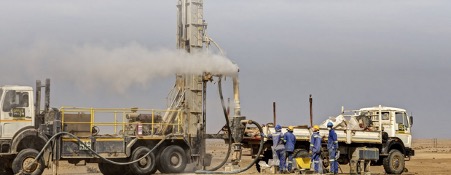Deep Yellow Limited (ASX:DYL) has obtained “highly positive” Definitive Feasibility Study (DFS) results for the Tumas Project in Namibia.
The results of the Tumas DFS show the flagship uranium project is a potential world-class operation delivering robust returns to shareholders.
“The release of the Tumas DFS is the most significant event to-date in our company’s history,” Managing Director/CEO, John Borshoff, said.
“We believe this is a very robust DFS and underscores the value of our conviction to apply effort in contrarian fashion, with a proven team, to discover the expanded Tumas Project that now demonstrates its potential to be a long-life, world-class uranium operation.
“Importantly, we have used appropriate assumptions and our costings are highly accurate, having been largely based on quotes received in the last quarter of 2022 and in January 2023, resulting in a very realistic outcome against the inflationary and supply headwinds that have hit the mining sector.
“We intend for Tumas to be a best-in-breed uranium operation with world-leading extractive technologies and sustainability initiatives applied, including a specific process route that will produce a benign1 tailings stream to allow for the eventual safe closure and rehabilitation.
“The Board has been suitably encouraged by the outcomes and the confidence it has in the team to continue to deliver and has authorised management to commence Front End Engineering and Design and advance project financing and offtake discussions over the course of this year.
“We also anticipate our application for a Mining Licence will be granted by mid-2023 once the Environmental Impact Assessment is assessed and approved by the authorities. If the outcome of these workstreams is positive, and suitable uranium market conditions prevail, we will be looking to make a Final Investment Decision by the first half of calendar year 2024.
“The development of Tumas is a cornerstone component of our long-held, dual-pillar growth strategy, which now also includes the Mulga Rock Project in WA, all to capitalise on the forecast improvement in uranium prices on the back of looming global uranium shortages from 2024. Our strategy encompasses organic growth of our own projects, and non-organic growth through consolidation in the sector.
“We remain strong believers in nuclear energy for electricity generation what with its growing role and importance both in combatting climate change by reducing global gas emissions and securing electricity supply for the future.”
DFS Highlights
A key feature of the DFS, compared to the Pre-Feasibility Study (PFS) outcome, is the increased production capacity of the plant from 3Mlbpa U3O8 to 3.6Mlbpa U3O8 (20%) and the increased throughput from 3.75Mtpa to 4.15Mtpa (11%). This has allowed positive economics to flow, despite a 26% increase in initial capital as a result of inflationary (and Covid) impacts over the past 2.25 years and the 20% increase in capacity.
On a cost per annual pound basis, initial capital for construction is now US$103/lb compared to US$98/lb in the PFS, a modest increase of only 5% over the 2.25 years. Production at this full rate of 3.6Mlb pa, on present stated reserves, will be for 10 years and overall LOM reduces slightly from 25.75 years to 22.25 years. This production rate increase has been made with the expectation of a potentially longer LOM for this project as has been previously reported. The considerable Inferred Resources are not considered in the DFS and, with 40% of the highly prospective Tumas paleochannel system remaining untested, the LOM is still realistically expected to exceed 30 years and production levels post year 10 are expected to be maintained at 3.6Mlbpa U3O8 for a substantially longer period.
For further information please visit: https://deepyellow.com.au/











